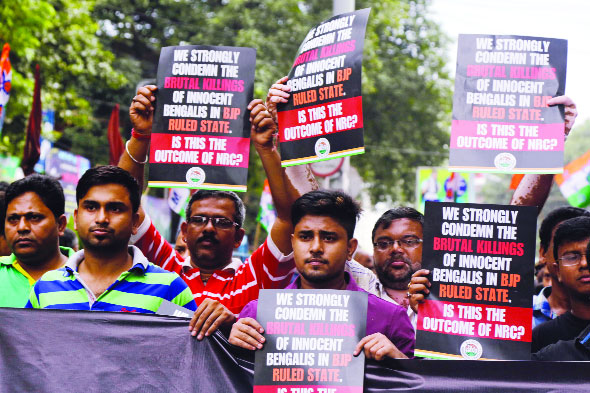Periodic clashes between indigenous and immigrant population are common in parts of the Northeast.
Is Assam going back to its dark days of the Bongal Kheda, a systematic ethnic cleansing of Bengali origin people whom it once considered colonisers and now see as bleeders of its natural resources and growth in an assertion of neo-Ahom identity? Is there a hitback following the NRC (National Register of Citizens) drive where the lines between settlers and immigrants have blurred, where the Hindu origin and Muslim immigrant residents have been lumped in the same basket as “foreigners” or “infiltrators” and is fuelling the current wave of hatred? Or is it that faced with the strong identity politics of the BJP, which came to power in 2016 on an anti-foreigner platform, the hawkish wing of the United Front of Liberation of Assam (ULFA) is reclaiming legitimacy?
Perhaps it is a tidal sentiment born of all the three insecurities. Nothing else can explain the savage killing of five Bengali Hindu farmers of Tinsukia district by suspected ULFA extremists. While the debate over inclusion of bhumiputras and exclusion of foreigners in the NRC rages, it has inadvertently opened the wounds of the state’s history, its hurt pride and a denial of equal opportunities. The indigenous versus outsiders divide has played out from the colonial era and has flared up periodically through clashes in parts of the Northeast, the latest being in Meghalaya. But the problem in Assam is one of disentangling genetics as one third of the population is Muslim, mostly of Bengali origin.
When the British took over from the Ahom kings in the early half of the 19th century, they manipulated the state’s demographics by relocating and resettling Bengali farmers as the territory was grossly underdeveloped. Encouraged by this policy, millions of Bengalis settled in Assam, rising in prominence in local businesses and civil administration. Understandably, they carved a negotiable niche for themselves as the colonial government rolled out a “grow more food” policy and put the local economy under their supervisory watch. The indigenous people were clearly left out of the political, administrative and most importantly economic discourse, a drift which has only grown wider post Independence.
Assam’s politics from 1940s onwards has been plagued by ethnic violence against Bengalis, who were cast as neo-imperialists and land-grabbers. In fact, the immigrant Muslims were in those early years encouraged by indigenous movements to wipe out Bengali Hindus, without realising that they too would become targets one day by virtue of their over-population. The subsequent language wars, whereby Assamese was posited as the official state language, only cemented the divide. Local political movements have used this to stake their claim, often through violent and genocidal means. And now that the NRC compilation has questioned the definition of who is Assamese and who is not, identity assertion is manifesting itself in troubling ways. What is disturbing is the gunmen are allegedly believed to have cited the Bengali support to the Citizenship Amendment Bill, 2016, which allows Hindu immigrants from neighbouring countries to become naturalised citizens. As the attack concerns Hindus, the BJP has a tough call ahead to reconcile local dynamics with its nationalist agenda.
Writer: Pioneer
Courtesy: The Pioneer








 OpinionExpress.In
OpinionExpress.In















Comments (0)